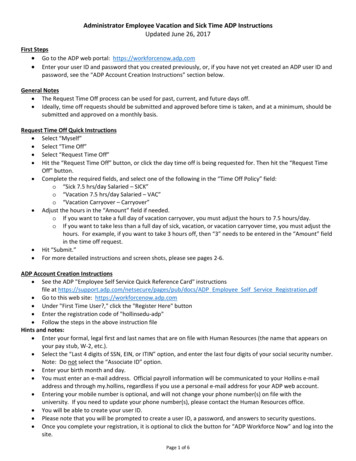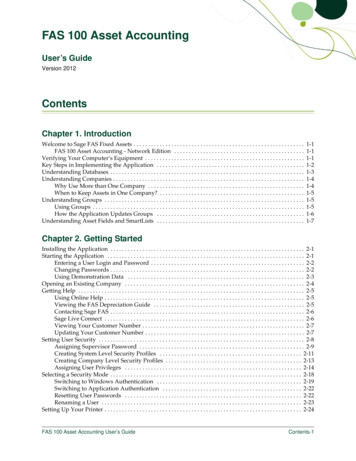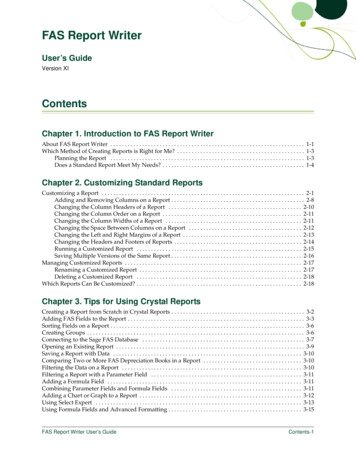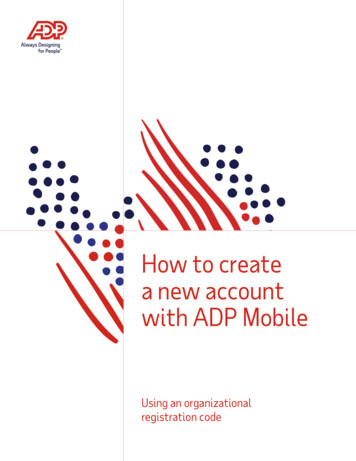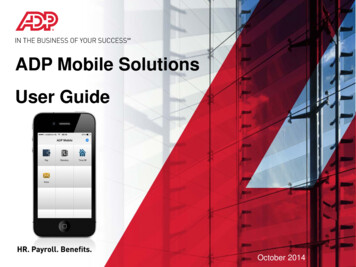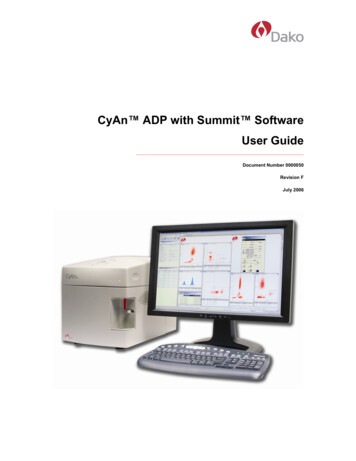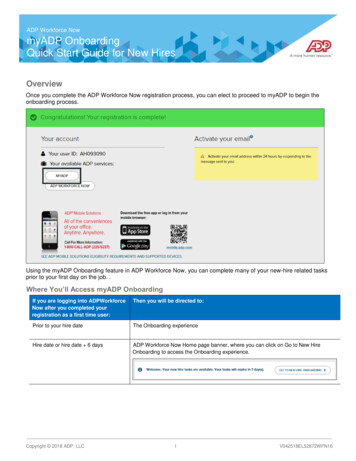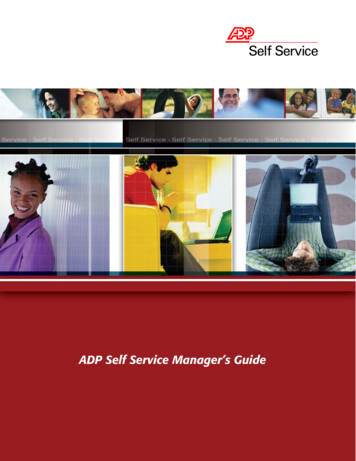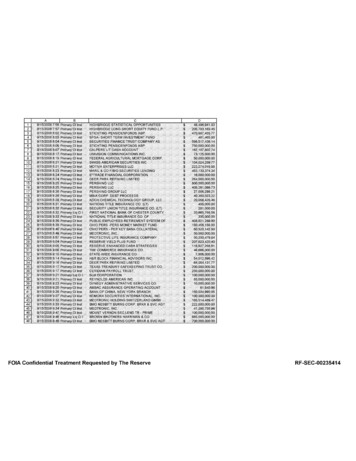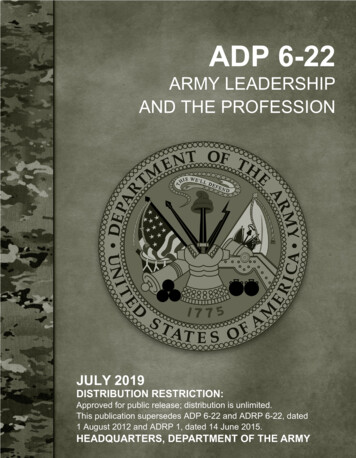
Transcription
ADP 6-22ARMY LEADERSHIPAND THE PROFESSIONJULY 2019DISTRIBUTION RESTRICTION:Approved for public release; distribution is unlimited.This publication supersedes ADP 6-22 and ADRP 6-22, dated1 August 2012 and ADRP 1, dated 14 June 2015.HEADQUARTERS, DEPARTMENT OF THE ARMY
This publication is available at the Army Publishing Directorate site(https://armypubs.army.mil/) and the Central Army Registry d).
*ADP 6-22Army Doctrine PublicationNo. 6-22HeadquartersDepartment of the ArmyWashington, DC, 31 July 2019ARMY LEADERSHIP AND THE PROFESSIONContentsPagePREFACE. ivINTRODUCTION . vChapter 1THE ARMY . 1-1A Shared Legacy . 1-1The Army Profession . 1-2Army Leadership . 1-3Army Leadership Requirements Model . 1-6Dynamics of Leadership . 1-8Roles of Leadership . 1-11Levels of Leadership . 1-13PART ONETHE ARMY LEADER: PERSON OF CHARACTER, PRESENCE, ANDINTELLECTChapter 2CHARACTER . 2-1Foundations of Army Leader Character . 2-1Army Values . 2-1Empathy. 2-8Warrior Ethos and Service Ethos . 2-8Discipline . 2-10Humility . 2-11Chapter 3PRESENCE . 3-1Foundations of Army Leader Presence . 3-1Military and Professional Bearing . 3-1Fitness . 3-1Confidence . 3-2Resilience . 3-2Chapter 4INTELLECT . 4-1Foundations of an Army Leader Intellect . 4-1Mental Agility . 4-1Sound Judgment . 4-2Innovation . 4-2Interpersonal Tact . 4-2Expertise . 4-3DISTRIBUTION RESTRICTION: Approved for public release; distribution is unlimited.*This publication supersedes ADP 6-22 and ADRP 6-22, both dated 1 August 2012, and ADRP 1, dated 14 June2015.ADP 6-22i
ContentsPART TWOCOMPETENCY-BASED LEADERSHIP FOR DIRECT THROUGHSTRATEGIC LEADERSChapter 5LEADS . 5-1Leads Others . 5-1Builds Trust . 5-8Extends Influence Beyond the Chain of Command . 5-9Leads by Example. 5-12Communicates . 5-14Chapter 6DEVELOPS . 6-1Develops Leaders . 6-1Prepares Self . 6-2Creates a Positive Environment/Fosters Esprit de Corps. 6-4Develops Others . 6-8Stewards the Profession . 6-14Chapter 7ACHIEVES . 7-1Gets Results . 7-1Purpose . 7-1Chapter 8LEADERSHIP IN PRACTICE . 8-1Leaders and Challenges . 8-1Leaders and Courage . 8-1Leadership and Management . 8-2Adaptability and Versatility . 8-2Challenges of an Operational Environment . 8-4Stress of Change . 8-6Operational Stress . 8-6Counterproductive Leadership . 8-7PART THREE LEADING AT ORGANIZATIONAL AND STRATEGIC LEVELSChapter 9ORGANIZATIONAL LEADERSHIP . 9-1Leading . 9-1Developing . 9-3Achieving . 9-6Chapter 10STRATEGIC LEADERSHIP . 10-1Leading . 10-2Developing . 10-5Achieving . 10-7SOURCE NOTES . Source Notes-1GLOSSARY . Glossary-1REFERENCES. References-1INDEX . Index-1iiADP 6-2231 July 2019
ContentsFiguresIntroductory figure 1. Logic map . viiFigure 1-1. The Army leadership requirements model . 1-6Figure 1-2. Navigating leader competencies . 1-7Figure 1-3. Army leadership levels. . 1-13Figure 5-1. General Eisenhower’s D-Day statement. 5-6TablesIntroductory table 1. New Army terms .viIntroductory table 2. Modified Army terms and acronyms .viTable 2-1. Attributes associated with CHARACTER . 2-12Table 3-1. Attributes associated with PRESENCE . 3-3Table 4-1. Attributes associated with INTELLECT . 4-5Table 5-1. The competency LEADS OTHERS . 5-8Table 5-2. The competency BUILDS TRUST . 5-9Table 5-3. The competency EXTENDS INFLUENCE BEYOND THE CHAIN OF COMMAND . 5-11Table 5-4. The competency LEADS BY EXAMPLE . 5-14Table 5-5. The competency COMMUNICATES . 5-16Table 6-1. The competency PREPARES SELF . 6-4Table 6-2. The competency CREATES A POSITIVE ENVIRONMENT . 6-8Table 6-3. Counseling—Coaching—Mentoring Comparison . 6-11Table 6-4. The competency DEVELOPS OTHERS . 6-14Table 6-5. The competency STEWARDS THE PROFESSION . 6-15Table 7-1. The competency GETS RESULTS . 7-331 July 2019ADP 6-22iii
PrefaceArmy doctrine publication (ADP) 6-22, Army Leadership and the Profession, establishes and describes thefoundations of Army leadership (including the Army Profession), outlines the echelons of leadership (direct,organizational, and strategic), and describes the attributes and core leader competencies expected of allleaders across all levels and cohorts.The principal audience for ADP 6-22 consists of all members of the Army, military and civilian. Trainersand educators throughout the Army will also use this publication. The use of the term Army leaders refers toofficers, noncommissioned officers, and select Department of the Army Civilians unless otherwise specified.Commanders, staffs, and subordinates ensure that their decisions and actions comply with applicable UnitedStates’, international, and host-nation laws and regulations. Commanders at all levels ensure their Soldiersoperate in accordance with the law of war and the rules of engagement (see FM 6-27).This publication contains copyrighted material.ADP 6-22 uses joint terms where applicable. Selected joint and Army terms and definitions appear in boththe text and glossary. When first defined in the text, terms for which ADP 6-22 is the proponent publicationare boldfaced and italicized, and definitions are boldfaced. When first defining other proponent definitionsin the text, the term is italicized and the proponent publication follows the definition. Following uses of theterm are not italicized. Terms for which ADP 6-22 is the proponent publication (the authority) are markedwith an asterisk (*) in the glossary. Underlined words are for emphasis; these are not formally defined terms.ADP 6-22 applies to the Regular Army, Army National Guard/Army National Guard of the United States,United States Army Reserve, and Department of the Army Civilians unless otherwise stated.The United States Army Combined Arms Center is the proponent of ADP 6-22. The preparing agency is theCenter for the Army Profession and Leadership, Mission Command Center of Excellence, United StatesArmy Combined Arms Center. Send written comments and recommendations on a DA Form 2028(Recommended Changes to Publications and Blank Forms) to Center for Army Profession and Leadership,ATTN: ATZL-MCV (ADP 6-22), 804 Harrison Drive, Bldg 472, Fort Leavenworth, KS 66027-2308 or byemail to ledgementsThese copyright owners have granted permission to reproduce material from their works.“How to Manage Alliances Strategically,” by Ha Hoang and Frank T. Rothaermel. 2016 from MIT SloanManagement Review/Massachusetts Institute of Technology. All rights reserved. Distributed by TribuneContent Agency, LLC.Making Partnerships Work: A Relationship Management Handbook, by Jonathan Hughes and Jeff Weiss.Reproduced with permission of Vantage Partners, LLC. Copyright 2001. All rights reserved.Leadership in Organizations, 8th ed by Gary Yukl. Reproduced with permission of the author. Copyright 2012.Republished with permission of the Academy of Management, from “Successful Organizational Change:Integrating the Management Practice and Scholarly Literatures,” Jeroen Stouten, Denise M. Rousseau, andDavid De Cremer, 12(2), 2018.ivADP 6-2231 July 2019
IntroductionADP 6-22 establishes and describes what leaders should be and do. Having a standard set of leader attributesand core leader competencies facilitates focused feedback, education, training, and development across allleadership levels. ADP 6-22 describes enduring concepts of leadership through the core competencies andattributes required of leaders of all cohorts and all organizations, regardless of mission or setting. Theseprinciples reflect decades of experience and validated scientific knowledge.An ideal Army leader serves as a role model through strong intellect, physical presence, professionalcompetence, and moral character. An Army leader is able and willing to act decisively, within superiorleaders’ intent and purpose, and in the organization’s best interests. Army leaders recognize thatorganizations, built on mutual trust and confidence, accomplish missions.Every member of the Army, military or civilian, is part of a team and functions in the role of leader andsubordinate. Being a good subordinate is part of being an effective leader. Leaders do not just leadsubordinates—they also lead other leaders. Leaders are not limited to just those designated by position, rank,or authority.Being and doing are ineffectual without knowledge. Knowing the what and how of soldiering, tactics,operational art, staff operations, functional and technical expertise, and many other areas are essential toleading well. ADP 6-22 cannot convey all of the specific knowledge areas to become an expert leader. Allleaders accrue the knowledge and develop the expertise required to contribute to the support and executionof the Army’s four strategic roles: shaping operational environments, preventing conflict, prevailing in largescale ground combat operations, and consolidating gains.ADP 6-22 describes the attributes and core competencies required of contemporary leaders. ADP 6-22addresses the following topics necessary for Army members to become a skilled, agile, and highly proficientArmy leader— Army definitions of leader, leadership, and counterproductive leadership. The Army leadership requirements model as a common basis for recruiting, selecting, developing,evaluating leaders and, most importantly, for leading Soldiers and Department of the Army (DA)Civilians. Roles and relationships of leaders, including the roles of subordinates or team members. What makes an effective leader: a person of integrity who builds trust and applies sound judgmentto influence others. How to lead, develop, and achieve through competency-based leadership. The basics of leading at the direct, organizational, and strategic levels. The influences and stresses of changing conditions that affect leadership.Key updates and changes to this version of ADP 6-22 include— Information from ADP 6-22 and ADRP 6-22 combined into a single document. Incorporation of key concepts (Army Profession and Army Ethic) from ADRP 1. New leadership requirements model diagram. New discussions on the dynamics of leadership, followers, humility, and counterproductiveleadership.ADP 6-22 contains 10 chapters comprising three parts describing the Army’s approach to leadership: Chapter 1 defines leadership, describes the foundations of Army leadership, identifies membersof the Army Profession, introduces the Army leadership requirements model, and addresses thevarious roles of Army leaders and the echelons of leadership.31 July 2019ADP 6-22v
Introduction Part One describes the leader attribute categories of character, presence, and intellect. Chapter 2discusses the attribute category of character: Army Values and Army Ethic, empathy, WarriorEthos/Service Ethos, discipline, and humility. Chapter 3 discusses the attribute category ofpresence: military and professional bearing, fitness, confidence, and resilience. Chapter 4discusses the attribute category of intellect: mental agility, sound judgment, innovation,interpersonal tact, and expertise.Part Two describes the core leader competencies and their application. Chapter 5 addresses thecompetency category of leads: leads others, builds trust, extends influence beyond the chain ofcommand, leads by example, and communicates. Chapter 6 describes the competency category ofdevelops: prepares self, creates a positive environment, develops others, and stewards theprofession. Chapter 7 describes the competency category of achieves and the supporting actionsof providing guidance, and managing and monitoring duties and missions. Chapter 8 discusses thechallenges of the operational environment, stress, and change.Part Three addresses the roles and responsibilities of organizational leaders in chapter 9 and ofstrategic leaders in chapter 10.Changes to terms used in ADP 6-22 are addressed in introductory tables 1 and 2. The logic map for ADP 6-22is shown in introductory figure 1.Introductory table 1. New Army termsTermRemarkscounterproductive leadershipNew term. ADP 6-22 is the proponent p
Army doctrine publication (ADP) 6-22, Army Leadership and the Profession, establishes and describes the foundations of Army leadership (including the Army Profession), outlines the echelons of leadership (direct, organizational, and strategic), and describes the a


